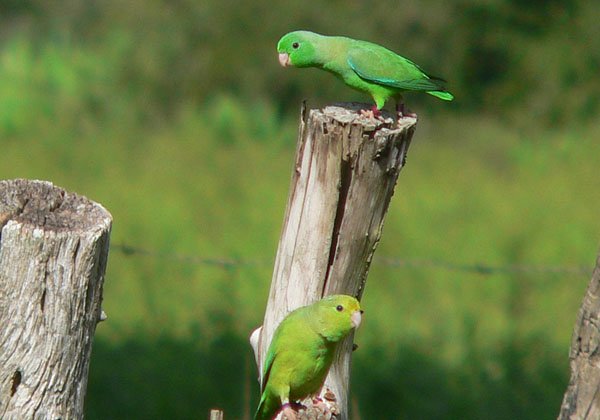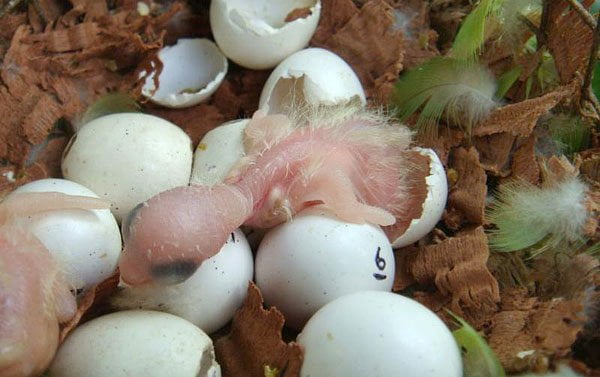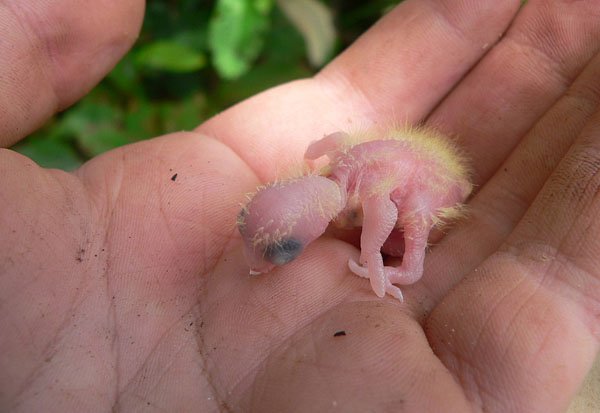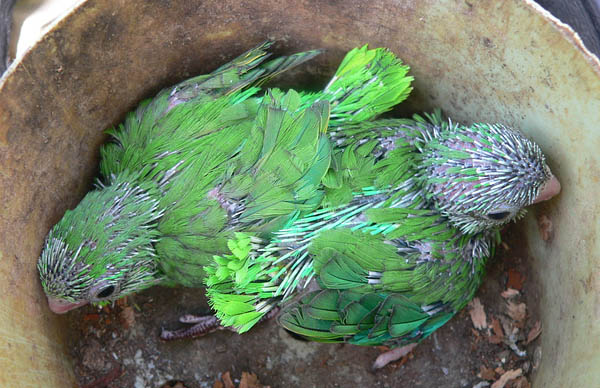Nick Sly, a friend of 10,000 Birds who writes intermittently at the thoroughly-recommended Biological Ramblings, is an ornithologist who graduated not so long ago from Cornell only to be cast out into the real world where he keeps a wry eye on all things biological! Back in October 2008, in his first field job out of school, he helped a Cornell PhD student, Karl, with his dissertation on vocal communication in Green-rumped Parrotlets Forpus passerinus. The population of parrotlets they studied was located on one of the many huge hatos (cattle ranches) in the Venezuelan llanos, a vast swath of flat flooded savannah in the central third of the country that drains into the Rio Orinoco.
Nick wrote a guest post on Forpus passerinus and the Ornithologists of Masaguaral which was full of passion, humor, and insight into his work while on location in Venezuela. Naturally, we wanted to hear more about parrotlets, so Nick graciously shared the beautiful photo-essay below.
To set the scene, we’ve re-posted the opening paragraph and photograph from Nick’s first post for us…
13 September 2008
Hato Masaguaral
Guarico, VenezuelaPhoto copyright Rae Okawa
The dawn sky breaks almost cloud free. Not good, I think – it will probably be another scorcher. My morning routine has already been simplified down to the essentials – roll out of bed and out from under the protective mosquito net, pull on dirty odorous field clothes, munch down a quick breakfast. Load up the gear – mini maglight in one breast pocket, field notebook and pencils in the other, big bottle of water, binoculars, camera. Lather on the SPF 50 sunblock and don my field hat. Empty out the rubber boots of any nighttime invaders before pulling them on. Backpack on, nest check clipboard attached, small folding chair over one shoulder, scope over the other shoulder.
Green-rumped Parrotlets: from egg to adult
Text and photographs copyright Nick Sly (except Rae Okawa where indicated) and are used with his permission.
You don’t really know a bird until you’ve studied it on its breeding grounds. Getting intimate with a species over the course of the breeding cycle is one of the more rewarding aspects of birding, and field research too. Last fall I traveled to the Venezuelan llanos and was introduced to the charming little Green-rumped Parrotlet Forpus passerinus. Over the course of three months of field work I monitored dozens of parrotlet nests from start to finish, taking care to snap some pictures now and again. I present here an annotated collection of photos documenting the entry of new parrotlets into this world.
A pair of Green-rumped Parrotlets
It all starts when a pair of parrotlets get that glint in their eyes. They select one of the Forpus project’s fine nesting boxes, defend it from other parrotlet pairs, and start to get cozy. Fire up the mood music, settle in for the night, and ten days later…
(Photo copyright Rae Okawa)
The female begins spending a lot of time in the nest box in the few days prior to laying. She lays an egg every day or two until completing a clutch of anywhere from five to ten eggs. The females begin incubation upon laying the first egg, and each egg takes about twenty days to hatch. With such a large, staggered clutch, sometimes the first egg hatches only a few days after the last egg is layed. During this whole time the parrotlet mother spends the majority of her time in the nest box incubating. She is largely dependent on being fed by the male, who is responsible for keeping her up to breeding weight, a hefty thirty grams. The male I’m sure is relieved when the chicks start hatching and the female begins leaving the nest to join in the foraging efforts.
Here is a little forpling on day one. What a completely helpless little ball of pink! They hatch out with a sparse yellow down covering parts of their frail bodies. In these pictures you can see the white egg tooth used for pipping the egg still attached to the front of the barely developed bill. The eyes are still not developed enough to open, and the feet are just strong enough to help right a toppled chick. At this point the chicks are mostly digestive tract. Note the crop already packed full of delicious yellow seeds by the doting Forpus parents.
The clutch hatches out very asynchronously due to the female’s constant incubation over the course of laying. The hatching period of the clutch can take a week or more. The result is the oldest nestlings being ten times the weight of the youngest chicks.
The youngest bird in this clutch is only two or three days old. (Color markings on the legs and head are to identify individuals for research purposes).
The female continues incubation and brooding during the first week or so after hatching starts, while the chicks are still naked and helpless. She then quickly begins spending the majority of her time away from the nest foraging with her mate. The parents come back for feeding visits every thirty to ninety minutes (we call the latter the ‘bad parents’!), stuffing the chicks full of delicious seeds, most commonly including seeds from species of Croton and Hyptus. The chicks take on an absurd appearance as the crop is so distended with food.
For the first ten days the appearance of the chick changes little except to grow in size. It takes a week for the eyes to develop enough to open. The beak becomes more defined and less a pink blob. The chick grows strong and coordinated enough to sit up, move around and beg actively. I call this time the ‘ugly stage’. (Note the smeared seeds on the larger bird’s face.)
(Photo copyright Rae Okawa) Big and strong enough to start coordinating their escape.
(Photos copyright Nick Sly and Rae Okawa)
Between ten and twenty days of age, the little forplings transition from the ‘ugly stage’ to the ‘cute stage’. They develop pin feathers, growing feathers still curled inside the sheath. The first pins to grow are the flight feathers, followed by pins growing over the entire body. My co-worker thinks a better name for them is porcupine parrotlets.
Over the course of the next several days, these pin feathers emerge and – poof! – a bright green young parrotlet is created.
A nearly full-grown female ready to fly any day now.
By 25 days of age, the forplings are quite mobile and largely resemble an adult. They readily climb up their nest chamber to beg for food from the entrance. Inside the nest they do a lot of stretching and flapping. They’re building up those muscles for the critical first flight. Here a male and female have climbed up to beg for food from the father perched outside.
(Photo copyright Rae Okawa)
By 30 days of age, the nestlings are quickly transitioning to fledglings. The oldest leave first, forcing the parents to divide their time between those left in the nest and those that have flown away. This sometimes seems to put pressure on the younger ones to take their first flights too. The behavior of the happy Forpus family after they leave the nest is still a relatively unknown subject, and is currently a subject of the Forpus project’s research. We do know that within one or two seasons, many of the fledglings that have departed will return to the fencelines of Masaguaral, ready to start the cycle anew.
Text and photographs copyright Nick Sly
References
Almost all of the nesting data and behavior work that has been mentioned in this post is the result of twenty years of research on Forpus passerinus by Steven Beissinger and colleagues. If you want more detailed knowledge of parrotlet behavior and nesting, check out these two references in particular:
- Beissinger, SR, and JR Waltman (1991) Extraordinary clutch size and hatching asynchrony of a neotropical parrot. The Auk 108: 863-871. Available from SORA: http://elibrary.unm.edu/sora/Auk/v108n04/p0863-p0871.pdf
- Waltman, JR, and SR Beissinger (1992) Breeding behavior of the Green-rumped Parrotlet. Wilson Bulletin 104(1): 65-84. Available from SORA: http://elibrary.unm.edu/sora/Wilson/v104n01/p0065-p0084.pdf

































These are great pictures..Thanks for putting on here to see..I too do Photography……Love these….
Thank you so much for the photos. Now if I could only find someone who can tell me what’s the deal with color yellow. I have a GR Parrotlet that goes into ‘defense’ mode everytime I put my (yellow) dish gloves on. Had the same reaction to a lemon, which is why I think it’s the color. Head down, swing back and forth and cheeping like crazy, she’ll get a hold of it and BITE, sometimes I can lift her off the cage and have to gently bounce her off. It’s really funny.
I also got these wind up toy rabbits, I’ll put them on floor and she’ll go after them and bite the eyes out. I don’t do it often, but when I do it’s halarious. My sweet, gentle bird morphs into the Green Gremlin.
Anyway, I was wondering if there was anything in the wild that resembles a yellow dish glove. A snake maybe? Another bird that’s a natural enemy?
Again, thank you for the photos. Very interesting information.
Great article Nick!! Thanks for the photos Rae Okawa…..-superb!!!
This is a very interesting piece on Parrotlets. I have some Green Rumps but they are not tame!!
This was a wonderful close-up view of how the precious Green Rump comes from egg to becoming a little adult. I have two and delight in watching them manuver and holding them daily. They are fantastic little companions and very affectionate. With a big parrot personality, they share their world with people.
Bizarre and fantastic.
A fascinating read Nick with excellent photos! My favorite part of the story was “pin feathers emerge and – poof! – a bright green young parrotlet is created!” Indeed.
My word for the day is so going to be “forpling”.
This is outstanding! I love the little ones all lined up by size. My parents took pictures of my siblings and me like that.
Thanks for a fascinating story and the transition from eggs to parrotlet is so well documented with your photos! I love the porcupine parrotlet stage!
I have (or, rather she has ME) a pacific parrotlet at home. She constantly amazes me with her intelligence and keeps me laughing with her antics! Tweedly is 12 years old at this writing, and in the pet shop SHE chose me! Doesn’t like not getting her own way, but has mellowed a little with age. Love her to pieces! Glad i could get a chance to view their ways in the wild!!! Thank you!
I love the pictures! I’m amazed that you could take the little ones out of the nest and put them back in without a problem from the parents. I first read the project in “Science” July 2011. I showed and read it to everyone who would listen. Thanks.
I have a yellow parrotlet and he has red markings on his head just wanted to know what kind of parrotlet he is I have been looking on google to find another bird like him n there isn’t one if you can find out what type he is I would appreiciate itthank you
Cool word forpling:)
Helpful information here and great fieldwork, Those stunning pics really added that imagery to the narrative.